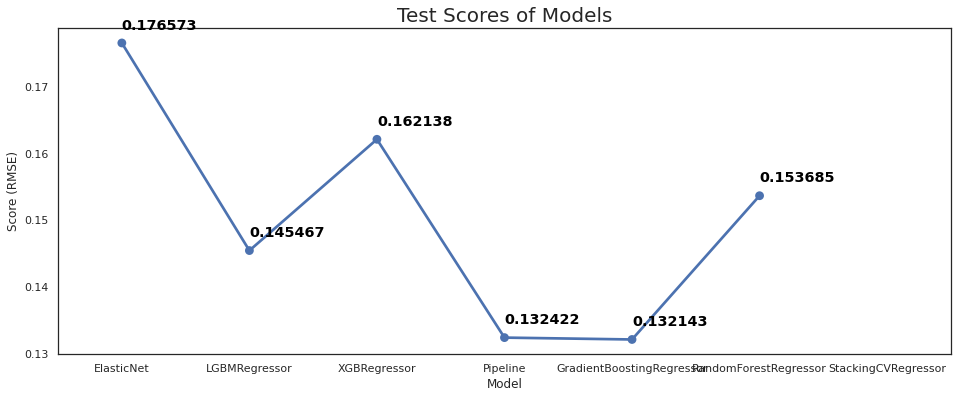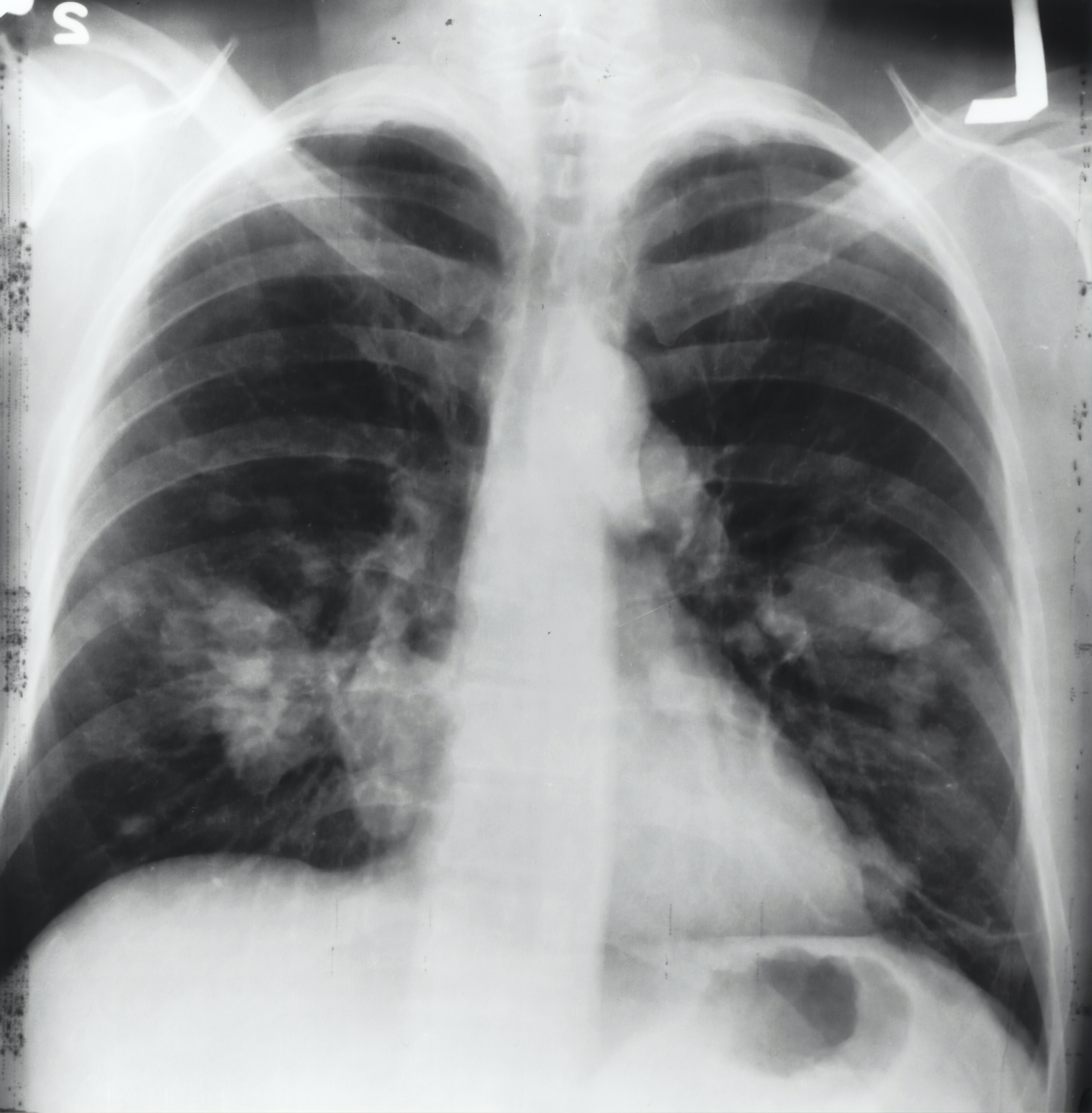Introduction
This blog post attempts to study the factors that influence the sale price of houses. To be specific, we will study the Ames Housing dataset , which can be downloaded from Kaggle.
import datetime
import random
import os
import numpy as np
import pandas as pd
import seaborn as sns
import matplotlib.pyplot as plt
from sklearn.kernel_ridge import KernelRidge
from sklearn.linear_model import Ridge, RidgeCV, ElasticNet, ElasticNetCV
from sklearn.svm import SVR
from sklearn.model_selection import GridSearchCV, KFold, cross_val_score, train_test_split
from sklearn.metrics import mean_squared_error
from sklearn.preprocessing import OneHotEncoder, LabelEncoder, scale
from sklearn.preprocessing import StandardScaler, RobustScaler
from sklearn.ensemble import RandomForestRegressor, GradientBoostingRegressor
from sklearn.pipeline import make_pipeline
from sklearn.decomposition import PCA
from scipy.special import boxcox1p
from scipy.stats import boxcox_normmax
from mlxtend.regressor import StackingCVRegressor
import lightgbm as lgb
from lightgbm import LGBMRegressor
from xgboost import XGBRegressor
Data Preprocessing and Exploring
The goal of this notebook is to predict SalePrice of houses
train_data = pd.read_csv('data/train.csv')
test_data = pd.read_csv('data/test.csv')
train_data.shape, test_data.shape
((1460, 81), (1459, 80))
train_data.head()
| Id | MSSubClass | MSZoning | LotFrontage | LotArea | Street | Alley | LotShape | LandContour | Utilities | LotConfig | LandSlope | Neighborhood | Condition1 | Condition2 | BldgType | HouseStyle | OverallQual | OverallCond | YearBuilt | YearRemodAdd | RoofStyle | RoofMatl | Exterior1st | Exterior2nd | MasVnrType | MasVnrArea | ExterQual | ExterCond | Foundation | BsmtQual | BsmtCond | BsmtExposure | BsmtFinType1 | BsmtFinSF1 | BsmtFinType2 | BsmtFinSF2 | BsmtUnfSF | TotalBsmtSF | Heating | ... | CentralAir | Electrical | 1stFlrSF | 2ndFlrSF | LowQualFinSF | GrLivArea | BsmtFullBath | BsmtHalfBath | FullBath | HalfBath | BedroomAbvGr | KitchenAbvGr | KitchenQual | TotRmsAbvGrd | Functional | Fireplaces | FireplaceQu | GarageType | GarageYrBlt | GarageFinish | GarageCars | GarageArea | GarageQual | GarageCond | PavedDrive | WoodDeckSF | OpenPorchSF | EnclosedPorch | 3SsnPorch | ScreenPorch | PoolArea | PoolQC | Fence | MiscFeature | MiscVal | MoSold | YrSold | SaleType | SaleCondition | SalePrice | |
|---|---|---|---|---|---|---|---|---|---|---|---|---|---|---|---|---|---|---|---|---|---|---|---|---|---|---|---|---|---|---|---|---|---|---|---|---|---|---|---|---|---|---|---|---|---|---|---|---|---|---|---|---|---|---|---|---|---|---|---|---|---|---|---|---|---|---|---|---|---|---|---|---|---|---|---|---|---|---|---|---|---|
| 0 | 1 | 60 | RL | 65.0 | 8450 | Pave | NaN | Reg | Lvl | AllPub | Inside | Gtl | CollgCr | Norm | Norm | 1Fam | 2Story | 7 | 5 | 2003 | 2003 | Gable | CompShg | VinylSd | VinylSd | BrkFace | 196.0 | Gd | TA | PConc | Gd | TA | No | GLQ | 706 | Unf | 0 | 150 | 856 | GasA | ... | Y | SBrkr | 856 | 854 | 0 | 1710 | 1 | 0 | 2 | 1 | 3 | 1 | Gd | 8 | Typ | 0 | NaN | Attchd | 2003.0 | RFn | 2 | 548 | TA | TA | Y | 0 | 61 | 0 | 0 | 0 | 0 | NaN | NaN | NaN | 0 | 2 | 2008 | WD | Normal | 208500 |
| 1 | 2 | 20 | RL | 80.0 | 9600 | Pave | NaN | Reg | Lvl | AllPub | FR2 | Gtl | Veenker | Feedr | Norm | 1Fam | 1Story | 6 | 8 | 1976 | 1976 | Gable | CompShg | MetalSd | MetalSd | None | 0.0 | TA | TA | CBlock | Gd | TA | Gd | ALQ | 978 | Unf | 0 | 284 | 1262 | GasA | ... | Y | SBrkr | 1262 | 0 | 0 | 1262 | 0 | 1 | 2 | 0 | 3 | 1 | TA | 6 | Typ | 1 | TA | Attchd | 1976.0 | RFn | 2 | 460 | TA | TA | Y | 298 | 0 | 0 | 0 | 0 | 0 | NaN | NaN | NaN | 0 | 5 | 2007 | WD | Normal | 181500 |
| 2 | 3 | 60 | RL | 68.0 | 11250 | Pave | NaN | IR1 | Lvl | AllPub | Inside | Gtl | CollgCr | Norm | Norm | 1Fam | 2Story | 7 | 5 | 2001 | 2002 | Gable | CompShg | VinylSd | VinylSd | BrkFace | 162.0 | Gd | TA | PConc | Gd | TA | Mn | GLQ | 486 | Unf | 0 | 434 | 920 | GasA | ... | Y | SBrkr | 920 | 866 | 0 | 1786 | 1 | 0 | 2 | 1 | 3 | 1 | Gd | 6 | Typ | 1 | TA | Attchd | 2001.0 | RFn | 2 | 608 | TA | TA | Y | 0 | 42 | 0 | 0 | 0 | 0 | NaN | NaN | NaN | 0 | 9 | 2008 | WD | Normal | 223500 |
| 3 | 4 | 70 | RL | 60.0 | 9550 | Pave | NaN | IR1 | Lvl | AllPub | Corner | Gtl | Crawfor | Norm | Norm | 1Fam | 2Story | 7 | 5 | 1915 | 1970 | Gable | CompShg | Wd Sdng | Wd Shng | None | 0.0 | TA | TA | BrkTil | TA | Gd | No | ALQ | 216 | Unf | 0 | 540 | 756 | GasA | ... | Y | SBrkr | 961 | 756 | 0 | 1717 | 1 | 0 | 1 | 0 | 3 | 1 | Gd | 7 | Typ | 1 | Gd | Detchd | 1998.0 | Unf | 3 | 642 | TA | TA | Y | 0 | 35 | 272 | 0 | 0 | 0 | NaN | NaN | NaN | 0 | 2 | 2006 | WD | Abnorml | 140000 |
| 4 | 5 | 60 | RL | 84.0 | 14260 | Pave | NaN | IR1 | Lvl | AllPub | FR2 | Gtl | NoRidge | Norm | Norm | 1Fam | 2Story | 8 | 5 | 2000 | 2000 | Gable | CompShg | VinylSd | VinylSd | BrkFace | 350.0 | Gd | TA | PConc | Gd | TA | Av | GLQ | 655 | Unf | 0 | 490 | 1145 | GasA | ... | Y | SBrkr | 1145 | 1053 | 0 | 2198 | 1 | 0 | 2 | 1 | 4 | 1 | Gd | 9 | Typ | 1 | TA | Attchd | 2000.0 | RFn | 3 | 836 | TA | TA | Y | 192 | 84 | 0 | 0 | 0 | 0 | NaN | NaN | NaN | 0 | 12 | 2008 | WD | Normal | 250000 |
5 rows × 81 columns
Next, we would like to understand the correlation between the target and other numerical features:
corrmat = train_data.corr()
f, ax = plt.subplots(figsize=(8, 6))
sns.heatmap(corrmat, vmax=.8, square=True)
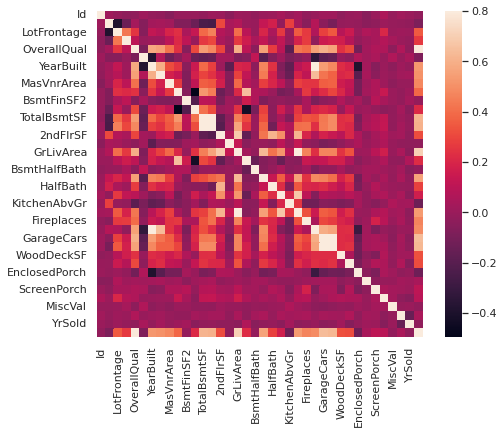
Next, we study the top 10 features that has the highest correlation to the target:
k = 10
cols = corrmat.nlargest(k, 'SalePrice')['SalePrice'].index
cm = np.corrcoef(train_data[cols].values.T)
sns.set(font_scale=1.25)
plt.subplots(figsize=(8, 6))
sns.heatmap(cm, cbar=True, annot=True, square=True, fmt='.2f', annot_kws={'size': 10}, yticklabels=cols.values, xticklabels=cols.values)
<matplotlib.axes._subplots.AxesSubplot at 0x7f3014d93d10>
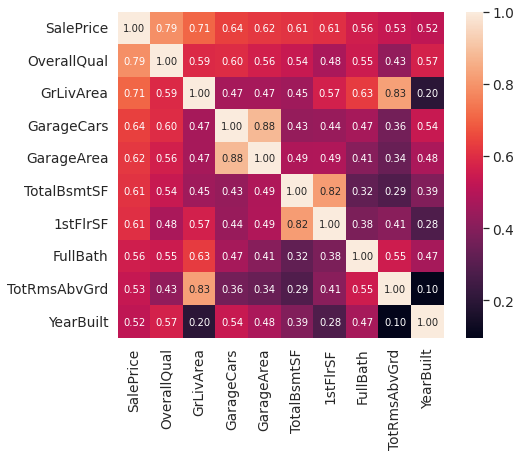
Following points can be infered from the heatmap:
- ‘OverallQual’ (Overall material and finish quality ), ‘GrLivArea’ (Above grade (ground) living area square feet) and ‘TotalBsmtSF’ (Total square feet of basement area) are strongly correlated with ‘SalePrice’, which totally makes sense
- 2 next highly collerated features are ‘GarageCars’ (Size of garage in car capacity) and ‘GarageArea’ (Size of garage in square feet). It is noteworthy that these two features indicate quite similar characteristics; indeed, ‘GarageCars’ is a consequence of ‘GarageArea’. The same applies to ‘TotalBsmtSF’ (Total square feet of basement area) and ‘1stFloor’
Next, we take a closer look to 5 intereseting features.
sns.set()
cols = ['SalePrice', 'OverallQual', 'GrLivArea', 'GarageCars', 'TotalBsmtSF', 'FullBath', 'YearBuilt']
sns.pairplot(train_data[cols], size = 2.5)
plt.show();
/usr/local/lib/python3.7/dist-packages/seaborn/axisgrid.py:2076: UserWarning: The `size` parameter has been renamed to `height`; please update your code.
warnings.warn(msg, UserWarning)
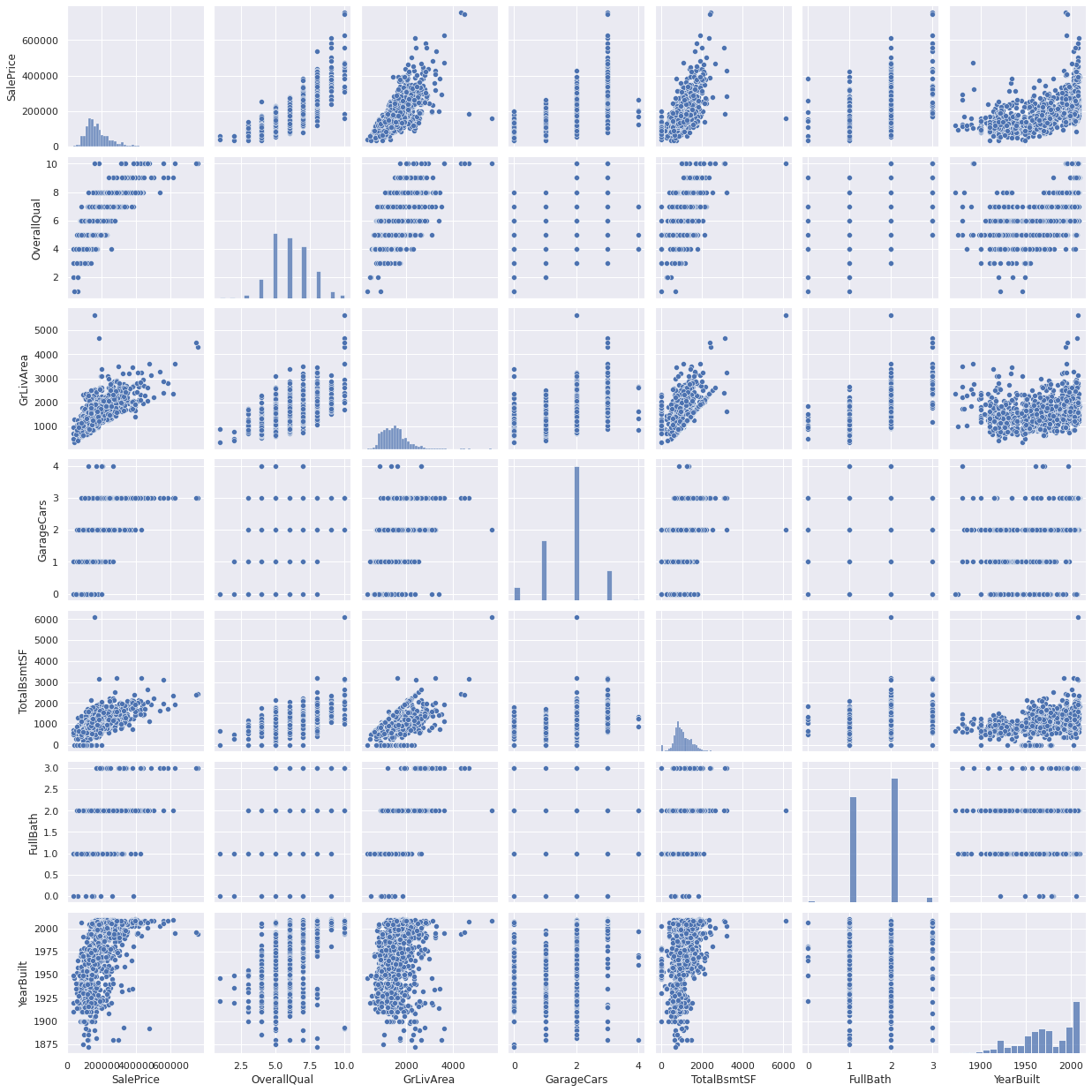
Subsequently, we would like to study the data on missing data:
total = train_data.isnull().sum().sort_values(ascending=False)
percent = (train_data.isnull().sum()/train_data.isnull().count()).sort_values(ascending=False)
missing_data = pd.concat([total, percent], axis=1, keys=['Total', 'Percent'])
missing_data.head(20)
| Total | Percent | |
|---|---|---|
| PoolQC | 1453 | 0.995205 |
| MiscFeature | 1406 | 0.963014 |
| Alley | 1369 | 0.937671 |
| Fence | 1179 | 0.807534 |
| FireplaceQu | 690 | 0.472603 |
| LotFrontage | 259 | 0.177397 |
| GarageCond | 81 | 0.055479 |
| GarageType | 81 | 0.055479 |
| GarageYrBlt | 81 | 0.055479 |
| GarageFinish | 81 | 0.055479 |
| GarageQual | 81 | 0.055479 |
| BsmtExposure | 38 | 0.026027 |
| BsmtFinType2 | 38 | 0.026027 |
| BsmtFinType1 | 37 | 0.025342 |
| BsmtCond | 37 | 0.025342 |
| BsmtQual | 37 | 0.025342 |
| MasVnrArea | 8 | 0.005479 |
| MasVnrType | 8 | 0.005479 |
| Electrical | 1 | 0.000685 |
| Utilities | 0 | 0.000000 |
There are several features that are mostly missed (> 80%). Since these features are not what we will consider when buying a house, we can safely drop them. Next, ‘FireplaceQu’ is something quite subjective and might be a source for outliers, so we also drop it.
Next, the ‘Garage…’ features seem to refer to the same phenomena, and they are actually highly related to ‘GarageCars’, therefore, they are safe to delete. The same applies to ‘Bsmt…’ features, which are related to ‘TotalBsmtSF’. Both ‘TotalBsmtSF’ and ‘GarageCars’ have been already considered.
The rest 3 features ‘MasVnrArea’ (Masonry veneer area in square feet), ‘MasVnrType’ (Masonry veneer type) and ‘Electrical’ (Electrical system) are 3 characteristics that do not really go into house price and can be replaced by the housebuyers, so we can drop these columns without losing much information. Besides, ‘MasVnrArea’ and ‘MasVnrType’ can be infered from ‘OverallQual’
train_data = train_data.drop((missing_data[missing_data['Total'] >= 1]).index,1)
train_data.isnull().sum().max() # check if all missing columns are handled
0
Next, we would like to see how the target is distributed
sns.set_style("white")
f, ax = plt.subplots(figsize=(8, 6))
sns.histplot(train_data['SalePrice'], color="b", kde=True, stat="density")
ax.set(title="SalePrice distribution")
sns.despine(trim=True, left=True)
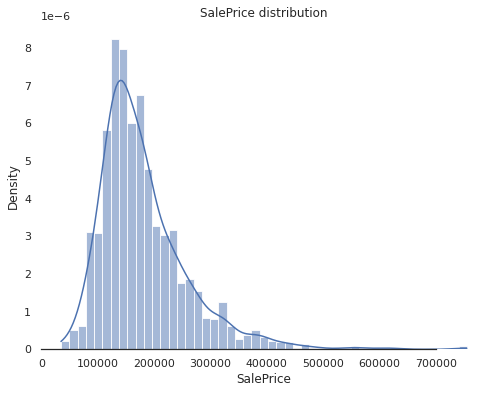
As in the plot, the SalePrice distribution is skewed from the normal distribution and shows peakedness. These values can be obtained as follows:
print("Skewness: %f" % train_data['SalePrice'].skew()) # skewness
print("Kurtosis: %f" % train_data['SalePrice'].kurt()) # deviation from the normal distribution
Skewness: 1.882876
Kurtosis: 6.536282
Since most ML models cannot handle non-normally distributed data very well, we should scale the feature appropriately. Recall that log transformation log(1+x) can fix the positive skewness. We apply this to the data and verified the transformed feature:
train_data["SalePrice"] = np.log1p(train_data["SalePrice"])
sns.set_style("white")
f, ax = plt.subplots(figsize=(8, 6))
sns.histplot(train_data['SalePrice'], color="b", kde=True, stat="density")
ax.set(title="SalePrice distribution")
sns.despine(trim=True, left=True)
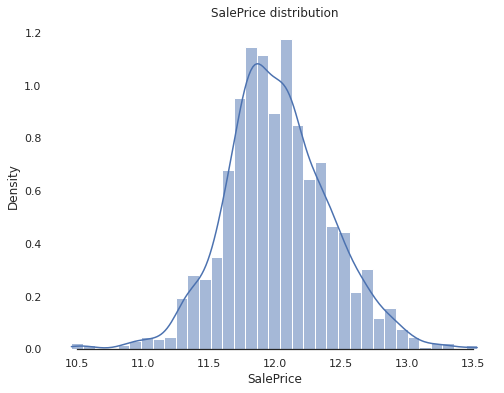
In the next step, we would like to fix skewed numerical features. The first thing to do is to create box plots for these features:
# get numeric columns
numerics = ['int16', 'int32', 'int64', 'float16', 'float32', 'float64']
numeric_data = train_data.select_dtypes(include=numerics)
# Create box plots for all numeric features
sns.set_style("white")
f, ax = plt.subplots(figsize=(10, 7))
ax.set_xscale("log")
ax = sns.boxplot(data=numeric_data , orient="h", palette="Set1")
ax.xaxis.grid(False)
ax.set(ylabel="Feature names")
ax.set(xlabel="Numeric values")
ax.set(title="Numeric Distribution of Features")
sns.despine(trim=True, left=True)
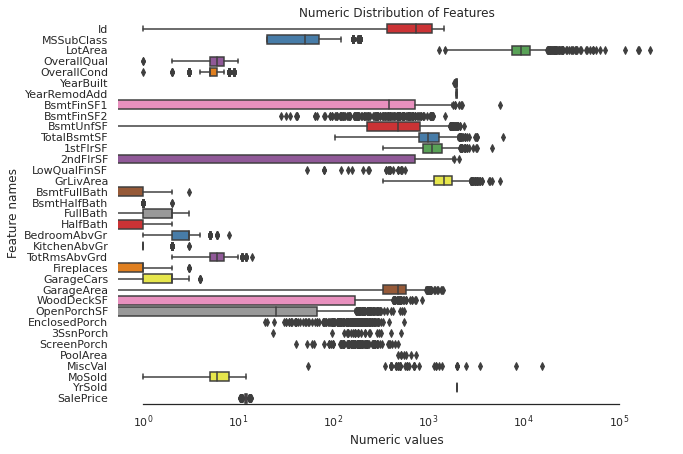
# Find skewed numerical features
skew_features = numeric_data.apply(lambda x: x.skew()).sort_values(ascending=False)
high_skew = skew_features[skew_features > 0.5]
skew_index = high_skew.index
print("There are {} numerical features with Skew > 0.5 :".format(high_skew.shape[0]))
skewness = pd.DataFrame({'Skew' :high_skew})
skew_features.keys()
There are 24 numerical features with Skew > 0.5 :
Index(['MiscVal', 'PoolArea', 'LotArea', '3SsnPorch', 'LowQualFinSF',
'KitchenAbvGr', 'BsmtFinSF2', 'ScreenPorch', 'BsmtHalfBath',
'EnclosedPorch', 'OpenPorchSF', 'BsmtFinSF1', 'WoodDeckSF',
'TotalBsmtSF', 'MSSubClass', '1stFlrSF', 'GrLivArea', 'BsmtUnfSF',
'2ndFlrSF', 'OverallCond', 'TotRmsAbvGrd', 'HalfBath', 'Fireplaces',
'BsmtFullBath', 'OverallQual', 'MoSold', 'BedroomAbvGr', 'GarageArea',
'SalePrice', 'YrSold', 'FullBath', 'Id', 'GarageCars', 'YearRemodAdd',
'YearBuilt'],
dtype='object')
We employ the Box-Cox transformation to normalize the skewed features
for i in skew_index:
train_data[i] = boxcox1p(train_data[i], boxcox_normmax(train_data[i] + 1))
/usr/local/lib/python3.7/dist-packages/scipy/stats/stats.py:3508: PearsonRConstantInputWarning: An input array is constant; the correlation coefficent is not defined.
warnings.warn(PearsonRConstantInputWarning())
/usr/local/lib/python3.7/dist-packages/scipy/stats/stats.py:3538: PearsonRNearConstantInputWarning: An input array is nearly constant; the computed correlation coefficent may be inaccurate.
warnings.warn(PearsonRNearConstantInputWarning())
numeric_data = train_data.select_dtypes(include=numerics)
# Create box plots for all numeric features
sns.set_style("white")
f, ax = plt.subplots(figsize=(10, 7))
ax.set_xscale("log")
ax = sns.boxplot(data=numeric_data , orient="h", palette="Set1")
ax.xaxis.grid(False)
ax.set(ylabel="Feature names")
ax.set(xlabel="Numeric values")
ax.set(title="Numeric Distribution of Features")
sns.despine(trim=True, left=True)
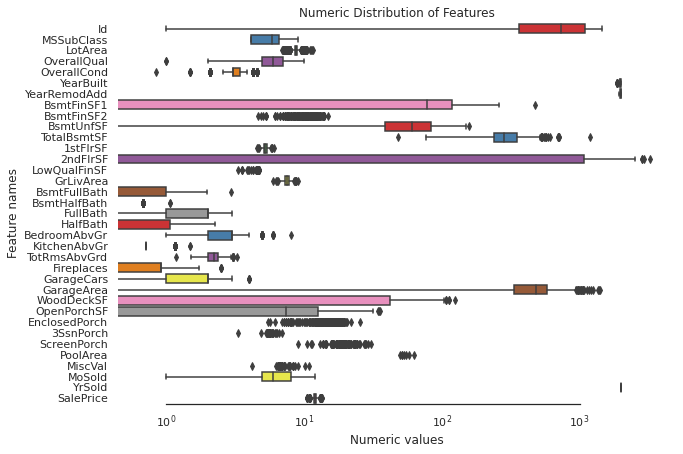
In the following, we encode and embed categorical feature:
# select categorical feazires
categorical_features = train_data.select_dtypes(include = ["object"]).columns
train_cat = train_data[categorical_features]
# one-hot encoding
train_cat = pd.get_dummies(train_cat)
train_cat.head()
| MSZoning_C (all) | MSZoning_FV | MSZoning_RH | MSZoning_RL | MSZoning_RM | Street_Grvl | Street_Pave | LotShape_IR1 | LotShape_IR2 | LotShape_IR3 | LotShape_Reg | LandContour_Bnk | LandContour_HLS | LandContour_Low | LandContour_Lvl | Utilities_AllPub | Utilities_NoSeWa | LotConfig_Corner | LotConfig_CulDSac | LotConfig_FR2 | LotConfig_FR3 | LotConfig_Inside | LandSlope_Gtl | LandSlope_Mod | LandSlope_Sev | Neighborhood_Blmngtn | Neighborhood_Blueste | Neighborhood_BrDale | Neighborhood_BrkSide | Neighborhood_ClearCr | Neighborhood_CollgCr | Neighborhood_Crawfor | Neighborhood_Edwards | Neighborhood_Gilbert | Neighborhood_IDOTRR | Neighborhood_MeadowV | Neighborhood_Mitchel | Neighborhood_NAmes | Neighborhood_NPkVill | Neighborhood_NWAmes | ... | Heating_GasW | Heating_Grav | Heating_OthW | Heating_Wall | HeatingQC_Ex | HeatingQC_Fa | HeatingQC_Gd | HeatingQC_Po | HeatingQC_TA | CentralAir_N | CentralAir_Y | KitchenQual_Ex | KitchenQual_Fa | KitchenQual_Gd | KitchenQual_TA | Functional_Maj1 | Functional_Maj2 | Functional_Min1 | Functional_Min2 | Functional_Mod | Functional_Sev | Functional_Typ | PavedDrive_N | PavedDrive_P | PavedDrive_Y | SaleType_COD | SaleType_CWD | SaleType_Con | SaleType_ConLD | SaleType_ConLI | SaleType_ConLw | SaleType_New | SaleType_Oth | SaleType_WD | SaleCondition_Abnorml | SaleCondition_AdjLand | SaleCondition_Alloca | SaleCondition_Family | SaleCondition_Normal | SaleCondition_Partial | |
|---|---|---|---|---|---|---|---|---|---|---|---|---|---|---|---|---|---|---|---|---|---|---|---|---|---|---|---|---|---|---|---|---|---|---|---|---|---|---|---|---|---|---|---|---|---|---|---|---|---|---|---|---|---|---|---|---|---|---|---|---|---|---|---|---|---|---|---|---|---|---|---|---|---|---|---|---|---|---|---|---|---|
| 0 | 0 | 0 | 0 | 1 | 0 | 0 | 1 | 0 | 0 | 0 | 1 | 0 | 0 | 0 | 1 | 1 | 0 | 0 | 0 | 0 | 0 | 1 | 1 | 0 | 0 | 0 | 0 | 0 | 0 | 0 | 1 | 0 | 0 | 0 | 0 | 0 | 0 | 0 | 0 | 0 | ... | 0 | 0 | 0 | 0 | 1 | 0 | 0 | 0 | 0 | 0 | 1 | 0 | 0 | 1 | 0 | 0 | 0 | 0 | 0 | 0 | 0 | 1 | 0 | 0 | 1 | 0 | 0 | 0 | 0 | 0 | 0 | 0 | 0 | 1 | 0 | 0 | 0 | 0 | 1 | 0 |
| 1 | 0 | 0 | 0 | 1 | 0 | 0 | 1 | 0 | 0 | 0 | 1 | 0 | 0 | 0 | 1 | 1 | 0 | 0 | 0 | 1 | 0 | 0 | 1 | 0 | 0 | 0 | 0 | 0 | 0 | 0 | 0 | 0 | 0 | 0 | 0 | 0 | 0 | 0 | 0 | 0 | ... | 0 | 0 | 0 | 0 | 1 | 0 | 0 | 0 | 0 | 0 | 1 | 0 | 0 | 0 | 1 | 0 | 0 | 0 | 0 | 0 | 0 | 1 | 0 | 0 | 1 | 0 | 0 | 0 | 0 | 0 | 0 | 0 | 0 | 1 | 0 | 0 | 0 | 0 | 1 | 0 |
| 2 | 0 | 0 | 0 | 1 | 0 | 0 | 1 | 1 | 0 | 0 | 0 | 0 | 0 | 0 | 1 | 1 | 0 | 0 | 0 | 0 | 0 | 1 | 1 | 0 | 0 | 0 | 0 | 0 | 0 | 0 | 1 | 0 | 0 | 0 | 0 | 0 | 0 | 0 | 0 | 0 | ... | 0 | 0 | 0 | 0 | 1 | 0 | 0 | 0 | 0 | 0 | 1 | 0 | 0 | 1 | 0 | 0 | 0 | 0 | 0 | 0 | 0 | 1 | 0 | 0 | 1 | 0 | 0 | 0 | 0 | 0 | 0 | 0 | 0 | 1 | 0 | 0 | 0 | 0 | 1 | 0 |
| 3 | 0 | 0 | 0 | 1 | 0 | 0 | 1 | 1 | 0 | 0 | 0 | 0 | 0 | 0 | 1 | 1 | 0 | 1 | 0 | 0 | 0 | 0 | 1 | 0 | 0 | 0 | 0 | 0 | 0 | 0 | 0 | 1 | 0 | 0 | 0 | 0 | 0 | 0 | 0 | 0 | ... | 0 | 0 | 0 | 0 | 0 | 0 | 1 | 0 | 0 | 0 | 1 | 0 | 0 | 1 | 0 | 0 | 0 | 0 | 0 | 0 | 0 | 1 | 0 | 0 | 1 | 0 | 0 | 0 | 0 | 0 | 0 | 0 | 0 | 1 | 1 | 0 | 0 | 0 | 0 | 0 |
| 4 | 0 | 0 | 0 | 1 | 0 | 0 | 1 | 1 | 0 | 0 | 0 | 0 | 0 | 0 | 1 | 1 | 0 | 0 | 0 | 1 | 0 | 0 | 1 | 0 | 0 | 0 | 0 | 0 | 0 | 0 | 0 | 0 | 0 | 0 | 0 | 0 | 0 | 0 | 0 | 0 | ... | 0 | 0 | 0 | 0 | 1 | 0 | 0 | 0 | 0 | 0 | 1 | 0 | 0 | 1 | 0 | 0 | 0 | 0 | 0 | 0 | 0 | 1 | 0 | 0 | 1 | 0 | 0 | 0 | 0 | 0 | 0 | 0 | 0 | 1 | 0 | 0 | 0 | 0 | 1 | 0 |
5 rows × 182 columns
# join numerical and categorical columns
train_data_preprocess = pd.concat([numeric_data, train_cat], axis = 1)
train_target = train_data_preprocess['SalePrice']
train_features = train_data_preprocess.drop('SalePrice', axis=1)
X_train, X_test, y_train, y_test = train_test_split(train_features, train_target, test_size = 0.3, random_state = 0)
X_train.shape, X_test.shape, y_train.shape, y_test.shape
((1022, 216), (438, 216), (1022,), (438,))
Next, we do the standardation separately for the training and test set. Note that we must not fit the StandardScaler on observations that are later used for testing
stdSc = StandardScaler()
numerical_features = X_train.select_dtypes(include=numerics).columns
X_train.loc[:, numerical_features] = stdSc.fit_transform(X_train.loc[:, numerical_features])
X_test.loc[:, numerical_features] = stdSc.transform(X_test.loc[:, numerical_features])
Model Definition
In this section, we train several models on the preprocessed datasets. The first step is to define a k-cross validator and the metrics:
# Setup cross validation folds
kf = KFold(n_splits=12, random_state=42, shuffle=True)
def rmsle(y, y_pred):
return np.sqrt(mean_squared_error(y, y_pred))
def cv_rmse(model, X=X_test, y=y_test):
rmse = np.sqrt(-cross_val_score(model, X, y, scoring="neg_mean_squared_error", cv=kf))
return rmse
# elastic net
from sklearn.linear_model import ElasticNet
elastic_net = ElasticNet(alpha=0.1, l1_ratio=0.5, random_state=42)
ElasticNet(alpha=0.1, random_state=42)
# Light Gradient Boosting Regressor
lightgbm = LGBMRegressor(objective='regression',
num_leaves=6,
learning_rate=0.01,
n_estimators=7000,
max_bin=200,
bagging_fraction=0.8,
bagging_freq=4,
bagging_seed=8,
feature_fraction=0.2,
feature_fraction_seed=8,
min_sum_hessian_in_leaf = 11,
verbose=-1,
random_state=42)
# XGBoost Regressor
xgboost = XGBRegressor(learning_rate=0.01,
n_estimators=6000,
max_depth=4,
min_child_weight=0,
gamma=0.6,
subsample=0.7,
colsample_bytree=0.7,
objective='reg:linear',
nthread=-1,
scale_pos_weight=1,
seed=27,
reg_alpha=0.00006,
random_state=42,
silent=True)
# Support Vector Regressor
svr = make_pipeline(RobustScaler(), SVR(C= 20, epsilon= 0.008, gamma=0.0003))
# Gradient Boosting Regressor
gbr = GradientBoostingRegressor(n_estimators=6000,
learning_rate=0.01,
max_depth=4,
max_features='sqrt',
min_samples_leaf=15,
min_samples_split=10,
loss='huber',
random_state=42)
# Random Forest Regressor
rf = RandomForestRegressor(n_estimators=1200,
max_depth=15,
min_samples_split=5,
min_samples_leaf=5,
max_features=None,
oob_score=True,
random_state=42)
# stack all defined models above, optimized with xgboost
stack_gen = StackingCVRegressor(regressors=(xgboost, lightgbm, svr, elastic_net, gbr, rf),
meta_regressor=xgboost,
use_features_in_secondary=True)
Model Fitting
model_scores = {}
def fit_model(model):
model_name = type(model).__name__
model.fit(X_train, y_train)
score = cv_rmse(model)
print("{} score: mean {:.4f} std {:.4f} ".format(model_name, score.mean(), score.std()))
model_scores[model_name] = (score.mean(), score.std())
models = [elastic_net, lightgbm, xgboost, svr, gbr, rf]
for model in models:
fit_model(model)
stack_gen.fit(np.array(X_train), np.array(y_train))
model_name = type(stack_gen).__name__
score = cv_rmse(stack_gen)
print("{} score: mean {:.4f} std {:.4f} ".format(model_name, score.mean(), score.std()))
model_scores[model_name] = (score.mean(), score.std())
print(model_scores)
{'ElasticNet': (0.17657340942074354, 0.03990470702503486), 'LGBMRegressor': (0.14546714293442034, 0.03976267856710425), 'XGBRegressor': (0.16213776204326213, 0.02940078347785184), 'Pipeline': (0.13242220591346968, 0.07109241750486699), 'GradientBoostingRegressor': (0.1321431159536556, 0.0387539517785031), 'RandomForestRegressor': (0.15368455919244703, 0.030021849118237243), 'StackingCVRegressor': (nan, nan)}
# Plot the predictions for each model
sns.set_style("white")
fig = plt.figure(figsize=(16, 6))
ax = sns.pointplot(x=list(model_scores.keys()), y=[score for score, _ in model_scores.values()], markers=['o'], linestyles=['-'])
for i, score in enumerate(model_scores.values()):
ax.text(i, score[0] + 0.002, '{:.6f}'.format(score[0]), horizontalalignment='left', size='large', color='black', weight='semibold')
plt.ylabel('Score (RMSE)')
plt.xlabel('Model')
plt.tick_params(axis='x')
plt.tick_params(axis='y')
plt.title('Test Scores of Models', size=20)
plt.show()
posx and posy should be finite values
posx and posy should be finite values
